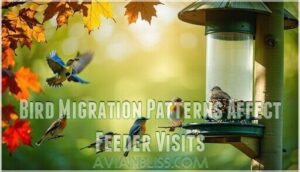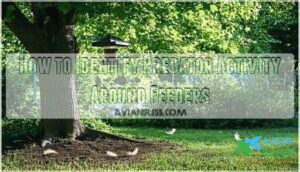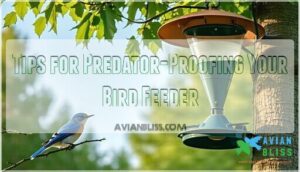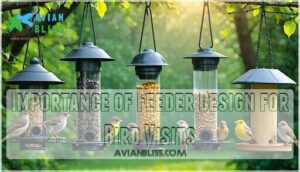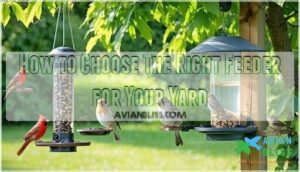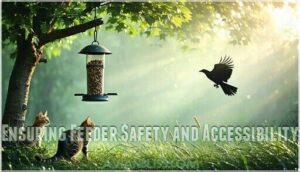This site is supported by our readers. We may earn a commission, at no cost to you, if you purchase through links.

Migration pulls entire flocks away as they follow routes hardwired into their DNA. A lurking hawk or neighborhood cat? That’ll clear out your yard fast.
Stale seed gets ignored—birds can tell the difference. Bad feeder placement, clunky designs, or crusty perches don’t help either.
Once you know what drives them off, you can fix it. Fresh seed, smart placement, and a little maintenance go a long way.
Table Of Contents
- Key Takeaways
- Natural Food Sources Abundant
- Mild Weather Reduces Feeder Visits
- Bird Migration Patterns Affect Feeder Visits
- Predators Deter Birds From Feeders
- Feeder Freshness and Quality Matter
- Feeder Design and Maintenance Affect Visits
- Creating a Bird-Friendly Environment
- Ensuring Feeder Safety and Accessibility
- Frequently Asked Questions (FAQs)
- Why have birds abandoned my feeder?
- Why are there no birds at my feeder?
- Why are my birds disappearing from my yard?
- Do birds disappear from your feeders?
- What causes birds to stop coming around?
- Why should you have a bird feeder in your backyard?
- Why do birds suddenly abandon feeders?
- Why are birds not coming to my feeder anymore?
- Why are birds dying around my bird feeder?
- How do I get my birds to come back to my feeder?
- Conclusion
Key Takeaways
- Birds skip feeders when natural food sources like berries, insects, and seeds become plentiful, especially during mild weather that reduces their energy needs and keeps wild food accessible longer. – Predators near feeders—including hawks, cats, and squirrels—create danger zones that drive birds away, with studies showing Cooper’s hawks now visit over 21% of backyard feeders compared to just 6% in 1989. – Spoiled or moldy seed causes feeder visits to drop by 40% within two weeks because birds detect poor quality quickly and avoid contaminated food that spreads diseases like salmonellosis. – Feeder placement, design, and maintenance matter more than most people realize—positioning feeders 10-12 feet from predator hiding spots, using proper drainage, and cleaning weekly keeps birds coming back consistently.
Natural Food Sources Abundant
When there’s plenty of natural food around, birds will usually pass up backyard feeders and stick with what’s growing wild.
So, what makes them choose one food source over another? Let’s take a closer look.
Effects of Bumper Crops on Bird Feeders
When nature dishes out a feast of acorns, berries, and wild seeds, your feeder suddenly looks like yesterday’s leftovers. Crop abundance shifts bird diets toward natural foraging, meaning a reduced dependence on your bird feeder.
Natural food availability provides better food quality and variety, and birds instinctively prefer these sources. Don’t take the feeder neglect personally—it’s actually a sign of a healthy ecosystem at work.
Types of Natural Food Sources Preferred by Birds
Birds gravitate toward natural food sources because they offer enhanced nutrition and variety. Native plant diversity is key—yards rich in native oaks and cherries can host over 500 caterpillar species, delivering critical insect protein sources for nesting birds. Native vegetation hosts more native-bird species.
Seasonal berry availability peaks in late summer, boosting visits by a third in some regions. Seeds from grasses and weeds provide essential energy, while peanuts—packed with nearly 50% fat—fuel migration. Seed size compatibility matters too; birds select fruits and seeds that fit their beaks, maximizing foraging efficiency and making natural food irresistible.
Impact of Mild Weather on Bird Feeding Habits
Warmer temperatures shift the equation—your feeder becomes optional when nature’s buffet is wide open. Mild weather effects reduce feeder reliance in three key ways:
- Energy need changes drop dramatically—birds burn less fuel staying warm, cutting demand for high-calorie seed.
- Natural food abundance explodes—insects swarm and berries ripen, offering richer nutrition than your feeder.
- Altered migration patterns delay departure—comfortable conditions mean birds linger longer where natural food availability thrives.
You’ll notice far fewer birds at your feeder when they have easier, tastier food waiting for them out in the wild.
Seasonal Changes in Bird Food Sources
Your backyard birds change their menu with the seasons—and once you catch on to the pattern, you’ll know exactly when to expect them.
Spring brings insects and worms, so birds ignore your feeder. Summer peaks with berries and bugs everywhere. Fall kicks off migration prep—acorns and native fruits become the priority. Winter strips away natural food sources, sending birds straight back to you.
These cycles trump everything else. Weather shifts and whatever’s growing nearby matter more than the fanciest feeder you can buy.
Mild Weather Reduces Feeder Visits
Comfortable weather means natural food is plentiful—insects are active, seeds are abundant, and birds can forage easily.
They’ll still visit feeders, but not as reliably. Your yard might see fewer visitors simply because they don’t need the extra calories.
How Mild Weather Affects Bird Migration Patterns
When mild weather arrives, migration timing shifts dramatically. North American species now reach nesting grounds 5 to 10 days earlier than decades ago, while fall departures stretch 17 days longer. These behavioral adaptations mean fewer birds visit your feeder during traditional migration windows.
As weather conditions shift, so do migration routes. Short-distance migrants adjust better to seasonal changes than long-distance travelers, altering species composition at feeders. Range adjustments also occur—some birds now winter 200 miles farther north, reducing energy expenditure on migration and changing when natural food availability peaks in your yard.
Alternative Food Sources During Mild Weather
When temperatures stay comfortable, nature’s pantry remains wide open, giving your feathered visitors plenty of reasons to skip the feeder. Natural food abundance peaks during mild spells, reducing your yard’s appeal. Here’s what birds find irresistible:
- Insect population boom: Warm conditions keep beetles, caterpillars, and spiders active—protein-rich meals that beat any seed mix for energy efficiency.
- Wild berry availability: Late-season fruits on dogwoods, hollies, and viburnums offer high-calorie snacks that require less foraging effort than visiting feeders.
- Seed-bearing plants: Native grasses and wildflowers still produce soft seeds, perfectly matching natural feeding habits birds evolved over millennia.
These natural food sources deliver better food quality while reducing energy needs, making your feeder’s convenience unnecessary.
Impact of Mild Weather on Bird Energy Needs
You mightn’t realize it, but comfortable conditions actually slash the calories birds burn just to survive each day. Thermoregulation ease means they’re not shivering through cold nights, so their metabolic slowdown kicks in naturally.
With reduced foraging pressure and natural food availability still strong, birds experience dietary shifts toward whatever’s easiest to find.
Weather conditions directly influence fuel-saving strategies, letting them thrive on less while natural food quality remains high through seasonal changes.
Bird Migration Patterns Affect Feeder Visits
Migration flips the script at your feeder. The birds you see in summer might vanish come fall, replaced by species just passing through or settling in for winter.
Timing of Bird Migration and Its Impact on Feeders
Migration doesn’t follow a strict calendar, and birds often pass through your area in waves that can leave feeders empty for days or even weeks. Peak migration periods can result in near-total feeder abandonment as birds prioritize natural food sources along their routes. Facultative migrants respond to seasonal changes and weather cues, making their movements less predictable.
Understanding these patterns helps explain:
- Why your regular visitors suddenly disappear during spring or fall
- How natural food availability affects seasonal bird behavior
- When to expect migration timing to influence feeder abandonment
These seasonal absences are completely normal parts of bird migration.
Changes in Bird Species Visiting Feeders During Migration
During migration, feeder bird diversity often declines by up to 35% as resident species leave and seasonal changes trigger species turnover. Over 40% of North American feeder birds show detectable shifts during migration, with some locations experiencing complete community replacement.
Temporal feeder patterns shift, and you might see White-throated Sparrows or Dark-eyed Juncos replacing summer warblers.
Geographic influences matter too—feeders near forested corridors see 15% more migrant species richness than urban sites, affecting visit frequency effects and overall bird feeder activity.
How to Attract Birds During Migration Seasons
Attracting migrants to your yard takes strategy—think of it as rolling out the welcome mat for birds who’ve just flown hundreds of miles and desperately need food, water, and a safe place to rest.
Set out high-energy bird food like sunflower seeds and suet near shelter during migration. Water availability matters too—add a birdbath.
Place feeders along natural food sources and consider species-specific needs for attracting birds to your garden.
Predators Deter Birds From Feeders
Hawks circling overhead, cats lurking in the bushes, foxes prowling at dusk—predators can turn your bird feeder into a hunting ground.
Watch for warning signs and take steps to protect your feathered visitors.
Common Predators That Affect Bird Feeder Visits
Predators create real trouble at bird feeders. Hawks, feral cats, squirrels, and corvids like crows and magpies all target feeding birds. Cooper’s hawks now visit over 21% of backyard feeders, a huge jump from just 6% in 1989. Managing predators in the yard starts with knowing who’s hunting around your feeder.
- Hawk predation affects sparrows and doves most, causing 30% drops in feeder activity when accipiters appear
- Cat threats drive birds away immediately, with feral cats hunting near feeders daily in many neighborhoods
- Squirrel impact includes both seed theft and nest predation, with corvids contributing to most robin nest losses
- Corvids presence increases 2.7 times in areas with many feeders, bringing higher nest predation rates
- Predation risk jumps near active feeders, with experimental nests showing 4 times higher losses than empty sites
How to Identify Predator Activity Around Feeders
Knowing what threats are actually present helps you protect visiting birds instead of just guessing at shadows. Look for predator tracks in soft ground or snow near your feeder. Watch for scared birds suddenly fleeing or refusing to land. Fewer visits often mean a hawk is perched nearby or feral cats are patrolling.
Check for feathers scattered below the feeder, which signal a predator strike. Signs of nest disturbance in nearby shrubs also reveal predator presence affecting your yard.
Tips for Predator-Proofing Your Bird Feeder
Once you spot the warning signs, a few smart adjustments can make your feeder a safer haven for visiting birds. Strategic feeder positioning protects against predators while maintaining accessibility. Try these deterrent methods:
- Baffle Designs: Mount cone or cylinder baffles below pole-mounted feeders to block climbing predators and squirrels.
- Feeder Placement: Position feeders in safe locations—at least 10 feet from cover where cats hide.
- Habitat Modification: Clear dense brush near feeders while keeping escape routes to trees.
- Monitoring Techniques: Regular observation helps you adjust placement when predator activity increases.
Feeder Freshness and Quality Matter
If the seed in your feeder is old or has gone bad, birds are likely to steer clear.
Keeping things fresh is the best way to make sure your backyard visitors keep coming back.
Importance of Fresh Seed in Bird Feeders
Birds can tell the difference between fresh and stale seed, and they’ll vote with their wings by skipping feeders that don’t meet their standards. Fresh seed offers better nutritional content and energy. Stale or moldy seed loses food quality and can harm birds.
Check your bird feeders weekly. Replace seed blends every two weeks, even if they look fine. Store bird food in airtight containers in cool, dry places. This simple seed storage habit keeps mold prevention strong and attracts birds consistently.
Effects of Spoilage on Bird Feeder Visits
What happens when your feeder fills with spoiled seed? Birds notice quickly and stay away. Moldy or wet seed loses nutritional value and spreads diseases like salmonellosis and aspergillosis among visiting birds. Studies show feeder visits can drop by 40% within two weeks when seed spoils.
Here’s what spoilage causes:
- Disease transmission increases at filthy feeders, with up to 70% of feeder-related outbreaks linked to poor maintenance and contaminated seed quality.
- Health impact from moldy seed includes respiratory problems and increased parasite loads, with spoiled food linked to 24% of feeder-associated bird deaths.
- Behavioral changes emerge as birds test and reject bad seed, spending more time searching elsewhere and avoiding your filthy birdbath area entirely.
Regular feeder maintenance and disease prevention through cleaning restore visits fast.
Tips for Storing and Maintaining Bird Seed Quality
Proper storage makes all the difference between seed that attracts dozens of birds and seed that sits ignored in your feeder. Store birdseed in airtight containers made of metal or heavy plastic to prevent moisture control problems and pest prevention issues. Keep containers in cool, dry locations away from direct sunlight.
This extends shelf life to 4-6 weeks while maintaining seed quality. Check stored food weekly for mold or insects, and discard any compromised batches immediately to keep your feeders appealing.
Feeder Design and Maintenance Affect Visits
Your feeder matters more than you’d think. The design, how often you clean it, whether you refill it regularly—all of that determines if birds stick around or disappear.
Importance of Feeder Design for Bird Visits
The way you set up your feeder can make the difference between a bustling bird café and an empty snack bar that nobody visits. Birds look for specific features when choosing where to eat:
- Port size that matches their beak dimensions
- Drainage holes to prevent mold and waterlogged seeds
- Perch design that holds their body size comfortably
- Baffle design to block squirrels and larger competitors
Feeder material and positioning also matter. Birds prefer feeders near shrubs where they can survey for predators before landing.
Tips for Cleaning and Maintaining Bird Feeders
Dirty feeders drive birds away faster than almost any other problem you can control. Mold prevention starts with weekly inspections during humid months. Scrub your bird feeders with hot water and safe detergents like diluted vinegar or mild dish soap. Rinse thoroughly and air-dry completely before refilling.
Routine checks catch spoiled seed early. Good feeder maintenance and hygiene aid disease prevention while keeping your yard welcoming.
How to Choose The Right Feeder for Your Yard
Your choice of feeder design matters just as much as what you put in it. Match the feeder size and style to the bird species you want to attract. Tube feeders work well for finches. Platform feeders welcome larger birds.
Consider these factors:
- Feeder material: Metal or durable plastic resists squirrels better than wood
- Feeder positioning: Place near cover but away from jumping points
- Budget considerations: Invest in quality designs that reduce competition and last longer
Creating a Bird-Friendly Environment
Birds won’t stick around if your yard doesn’t meet their basic needs for food, water, and shelter.
A few simple upgrades can make your yard the kind of spot birds come back to day after day.
Importance of Habitat and Bird Activity
Think of your yard as a mosaic—each piece matters when attracting backyard birds. Habitat fragmentation and urbanization effects shape which species visit your feeders. Research shows fragmented landscapes increased sustained bird activity for 61% of observed birds, while urban areas fostered twice as many wintering birds compared to rural sites.
Understanding how micro-habitat influence, human activity, and seasonal patterns interact helps you create welcoming bird habitats that complement natural food sources.
| Habitat Feature | Impact on Bird Activity |
|---|---|
| Native plants and shrubs | Provides shelter and natural food sources year-round |
| Canopy cover | Increases occupancy rates and detection probability |
| Dense vegetation | Improves functional connectivity for urban songbirds |
| Green space structure | Reduces negative effects of road gaps on feeder visits |
| Low pesticide areas | Fosters greater bird abundance and diversity |
Tips for Creating a Bird-Friendly Yard
Once you’ve shaped a habitat that draws birds in, you can take practical steps to make your yard even more inviting. Start with these essentials:
- Plant native species that provide natural food sources like berries, seeds, and insects throughout the year
- Add a bird bath or water features near your bird feeder for drinking and bathing
- Provide shelter options like dense shrubs and nesting sites where birds feel secure
Smart feeder positioning near cover creates a safe environment. Skip pesticides to protect the insects birds need.
How to Attract Birds With Water Sources
Water does more than quench thirst—it can turn a quiet yard into a bustling bird hub if you set it up with their needs in mind. Birds need shallow water for bathing and drinking. A clean birdbath placed near your bird feeder becomes a natural gathering spot. Here’s what works:
- Keep water shallow—one to two inches deep lets birds bathe safely without risk of drowning
- Change water every two days to prevent a filthy birdbath that spreads disease and mosquito larvae
- Add rocks or pebbles so birds can grip surfaces and adjust water depth
- Position near cover like shrubs so wet birds can escape predators quickly
- Consider fountain designs with gentle dripping sounds that attract birds from greater distances
- Monitor water quality during freezing weather and hot summers when birdbath maintenance matters most
Water features and pond installation offer year-round appeal when maintained properly.
Ensuring Feeder Safety and Accessibility
Placement can make or break your feeder setup—it’s just as important as the food itself. Two factors will help you create a spot that’s both safe and attractive to birds.
Tips for Placing Feeders to Avoid Predators
Placing your feeder in the right spot can mean the difference between a safe feeding station and a predator’s hunting ground.
Position your bird feeder at least 10 to 12 feet from shrubs or trees where predators hide. Keep it 5 feet off the ground so cats can’t pounce. Add baffles or cages as predator deterrents.
Good feeder positioning gives birds clear sightlines to spot danger and quick escape routes to nearby cover.
Importance of Quiet and Undisturbed Areas for Feeders
Birds are surprisingly sensitive to disturbances, and even minor commotion can send them looking for calmer dining spots. Noise reduction and disturbance minimization directly influence feeder positioning success. Loud environmental changes like traffic, construction, or frequent human activity create stressful habitat conditions that discourage wildlife visits.
Consider these quiet zone strategies:
- Choose calm corners – Position your bird feeder away from driveways, patios, and high-traffic areas where sudden movements startle birds.
- Buffer noise sources – Use natural barriers like shrubs or fences to create peaceful bird sanctuaries that absorb sound.
- Limit activity nearby – Keep feeder placement separate from play areas or lawn maintenance zones where disruptions occur regularly.
Undisturbed areas help birds feed confidently and return consistently.
Frequently Asked Questions (FAQs)
Why have birds abandoned my feeder?
Several factors affecting bird feeder use can cause abandonment. Seasonal changes, feeder placement, food variety, and environmental factors all influence visits.
Bird diseases, predators, and natural food abundance are common reasons for bird feeder abandonment. Understanding these helps prevent future problems.
Why are there no birds at my feeder?
Studies show nearly 100% feeder abandonment during peak migration. Seasonal patterns, environmental factors, and bird behavior all influence feeder activity.
Common reasons for bird feeder abandonment include abundant natural food, predators, poor feeder placement, or low food variety affecting your bird feeder.
Why are my birds disappearing from my yard?
When feeder abandonment expands to an entire yard, seasonal shifts, predators, yard modifications, or bird diseases may drive population decline.
Environmental factors like habitat loss affect bird behavior more broadly than feeder placement alone.
Do birds disappear from your feeders?
Yes, bird feeder activity naturally fluctuates throughout the year. Seasonal changes, food variety in nature, and environmental factors all influence feeder placement effectiveness.
Population decline isn’t always the reason—birds simply shift their behavior based on immediate needs and available resources.
What causes birds to stop coming around?
Understanding factors influencing bird behavior helps you solve the mystery. Seasonal changes, environmental factors, predators, bird diseases, feeder hygiene, human activity, and competition all affect bird feeder activity and can explain reasons for bird disappearance.
Why should you have a bird feeder in your backyard?
Have you noticed cardinals gathering at dawn, chickadees investigating your yard, or warblers pausing during migration? Installing a bird feeder transforms your backyard habitat into a wildlife aid hub.
Bird watching becomes seamless. You help bird conservation while creating welcoming bird habitats.
Attracting and maintaining birds enriches your garden improvement efforts, connecting bird enthusiasts with nature’s rhythms in eco-friendly ways.
Why do birds suddenly abandon feeders?
Why does your once-bustling bird feeder now sit empty? Seasonal shifts, environmental factors, and molting periods drive birds away.
Abundant natural food, mild weather reducing energy needs, migration timing, predators near feeders, spoiled seed, and poor feeder placement all contribute to preventing bird feeder abandonment.
Why are birds not coming to my feeder anymore?
When’s the last time you checked your feeder? Natural food sources like berries and seeds might be plentiful right now, or mild weather reduces energy needs.
Seasonal patterns, bird diseases, and environmental factors also affect visits.
Check feeder placement, food variety, and birdseed freshness—feeder hygiene matters too.
Why are birds dying around my bird feeder?
How can you tell if your feeder has become a hazard? Disease transmission at bird feeders happens when contaminated seed or filthy birdbath water spreads avian diseases like salmonellosis.
Bacterial contamination and mold growth from poor feeder hygiene cause bird toxicity.
Clean feeders weekly to prevent deaths.
How do I get my birds to come back to my feeder?
Getting birds back starts with feeder cleaning and fresh seed variety. Refill your bird feeder regularly with quality bird food.
Improve feeder placement near cover, enrich habitat with water sources, and maintain feeder hygiene.
Upgrade feeder design if needed, then wait patiently.
Conclusion
Feeder fixes foster faithful flocks. Understanding why birds abandon a bird feeder helps you create a welcoming space they’ll return to daily. Fresh seed, clean feeders, and smart placement make all the difference.
Watch for predators and adjust your setup as seasons change. Natural food sources compete for their attention, but a well-maintained station offers reliable meals year-round.
Your efforts transform your yard into a thriving bird sanctuary that benefits both you and your feathered friends.
- https://www.allaboutbirds.org/news/im-seeing-fewer-birds-in-my-yard-is-something-affecting-their-populations/
- https://www.birdwatchingdaily.com/beginners/birding-faq/julie-craves-explains-why-birds-sometimes-abandon-feeders/
- https://pmc.ncbi.nlm.nih.gov/articles/PMC4778448/
- https://bwdmagazine.com/backyard-birding-time/bird-feeding/does-bird-feeding-affect-bird-behavior/
- https://senr.osu.edu/news/feeding-your-feathered-friends-study-finds-complex-relationships-among-bird-feeders-predators


